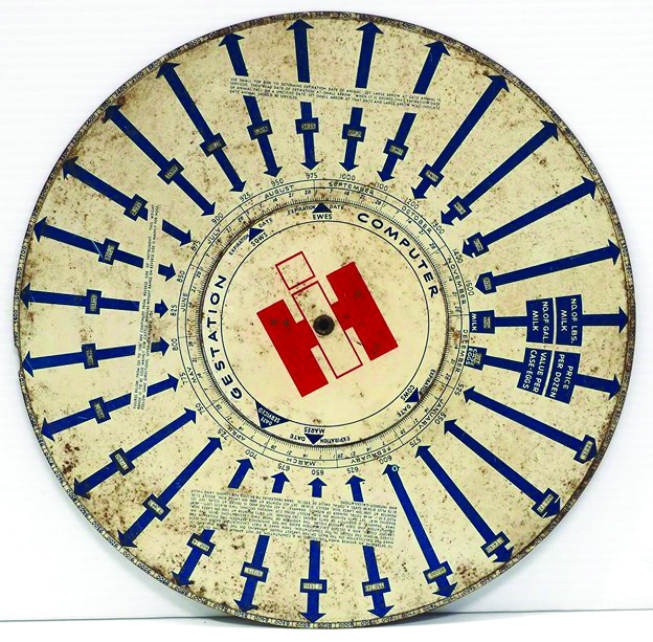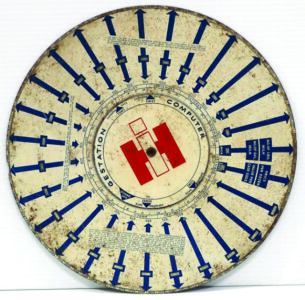Kovels Antiques: Farm calculators existed long before the apps

“But when are we going to use this in real life?” That question comes up in math classes, much to the chagrin of many teachers. It’s not just a classroom cliche to say that math is everywhere, from planning a budget to decorating a room. Even careers that aren’t directly connected to math require plenty of it. Take agriculture. Today, an online search can bring up farm calculator apps designed to help determine, for example, how much fertilizer a field requires, fuel efficiency of farm equipment, or predictions for product yields.
Farm calculators have existed long before apps, of course. This vintage piece, which sold at Chupp Auctions & Real Estate for $120, has calculations regarding livestock on one side and plant crops on the reverse. The dials turn to calculate the values. It was one of several types of farm calculators made and sold by International Harvester (IH), which was in business from 1902 to the mid-1980s.
Other calculators of theirs include simple cards printed with charts of a truck’s miles per gallon; slide or dial calculators made of cardboard or tin that helped determine harvest rates and yields; and electric calculators sized for a pocket or desktop and marked with the company’s logo. They were an effective form of advertising. In addition to being a useful tool, these calculators implied that International Harvester was the solution to whatever problem a farmer had.
* * *
Q: My makeup stand, made from paulownia wood in Japanese-occupied Korea, had its original mirror broken when we moved. The replacement glass is too massive and overbalances the mirror. Can you recommend where to look for thinner antique mirror glass?
A: Japan occupied Korea from 1910 to 1945, providing a date range for your stand. Paulownia is a hardwood grown in East Asia, both as an ornamental tree and for its wood. It is especially popular in Japanese woodworking; in Japan, it is called kiri. The wood is very light but strong and resists warping, and it is traditionally used for items like musical instruments and boxes. Look for antique furniture restorers or repairers in your area to find appropriate glass for your stand. Some companies that make glass for mirrors and windows make custom thicknesses and may be able to accommodate your need. Because of the origin of your stand and its type of wood, a company that does Japanese woodworking, sells tools, or teaches classes in it, may also be able to help you.
* * *
Q: In my late mother’s effects, I found two small binders designed to hold 14 45-rpm records each. One or two of the sleeves are empty. All the records in them are by well-known artists of the 1940s and 1950s (Glenn Miller, Doris Day, Al Martino, etc.) and a few well-known labels (Columbia, Capitol, etc.). Are these relatively recent creations worth nothing in dollars or might at least some of them have value?
A: Record collecting has grown in popularity over the past couple of decades, primarily driven by nostalgia; aesthetic aspects like the album art and superior sound; and, especially among younger generations, the desire for a break from the dominance of digital products. Like most collectibles, the records that sell for the highest prices are usually the rarest ones. Because yours are by well-known artists and labels, they may not sell for very high prices unless they are especially rare editions. However, they will probably still sell. Check specialist websites like Discogs (discogs.com), Goldmine Magazine (goldminemag.com), or Money Music (moneymusic.com) for more information about your records and their values.
* * *
TIP: Tin signs and cans will fade from the ultraviolet rays coming in a window or from a fluorescent light. Plexiglas UF-1 or UF-3 will cover the window and keep the rays away from your collection. There are also plastic sleeves to cover fluorescent tubes.
* * *
Kovels answers readers’ questions sent to the column. Send a letter with one question describing the size, material (glass, pottery) and what you know about the item. Include only two pictures: the object and a closeup of any marks or damage. Be sure your name and return address are included. By sending a question, you give full permission for use in any Kovel product. Names, addresses or email addresses will not be published. We do not guarantee the return of photographs, but if a stamped envelope is included, we will try. Questions that are answered will appear in Kovels Publications. Write to Kovels, (Name of this newspaper), King Features Syndicate, 300 W. 57th Street, 41st Floor, New York, NY 10019, or email us at collectorsgallery@kovels.com.

